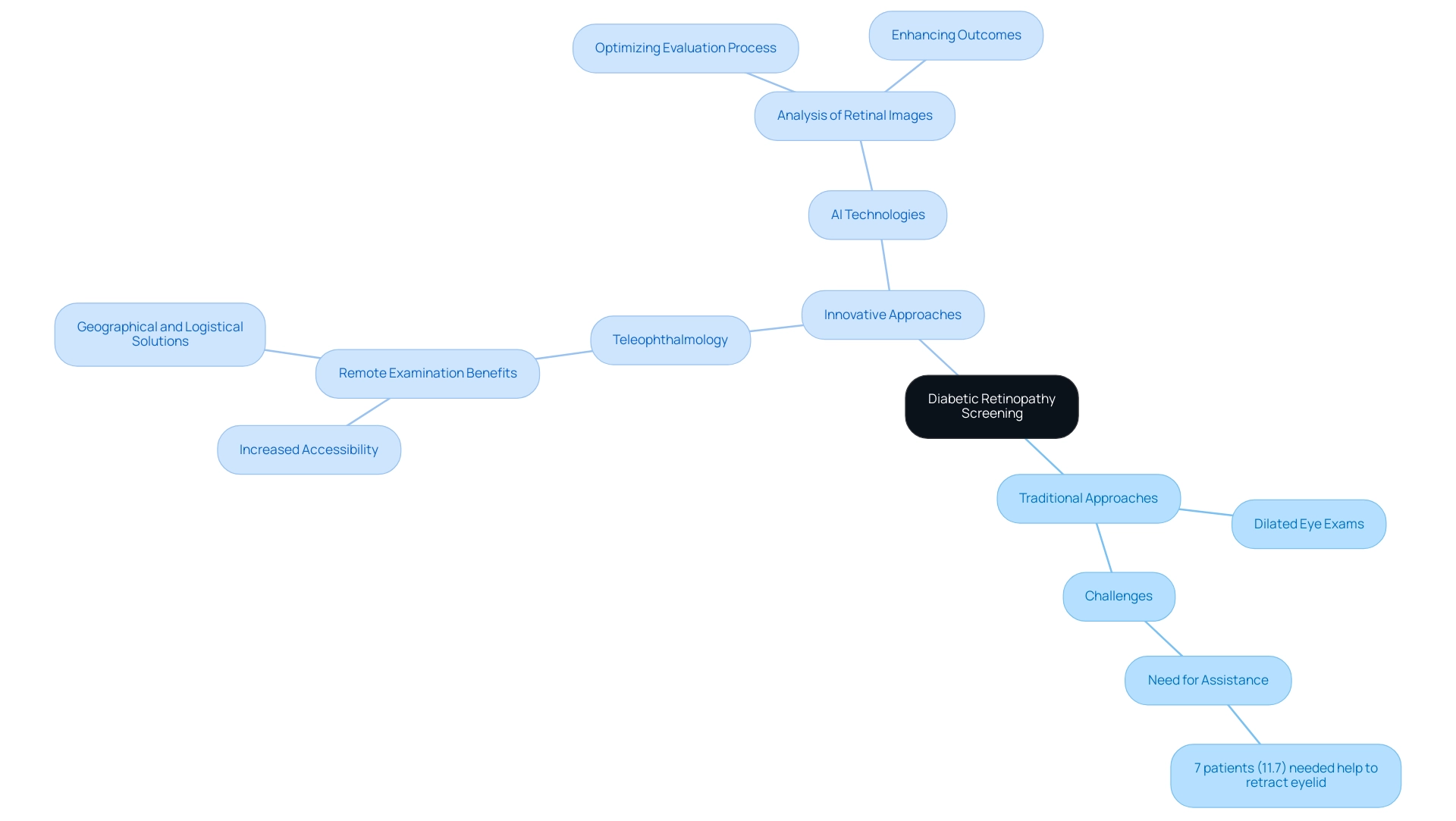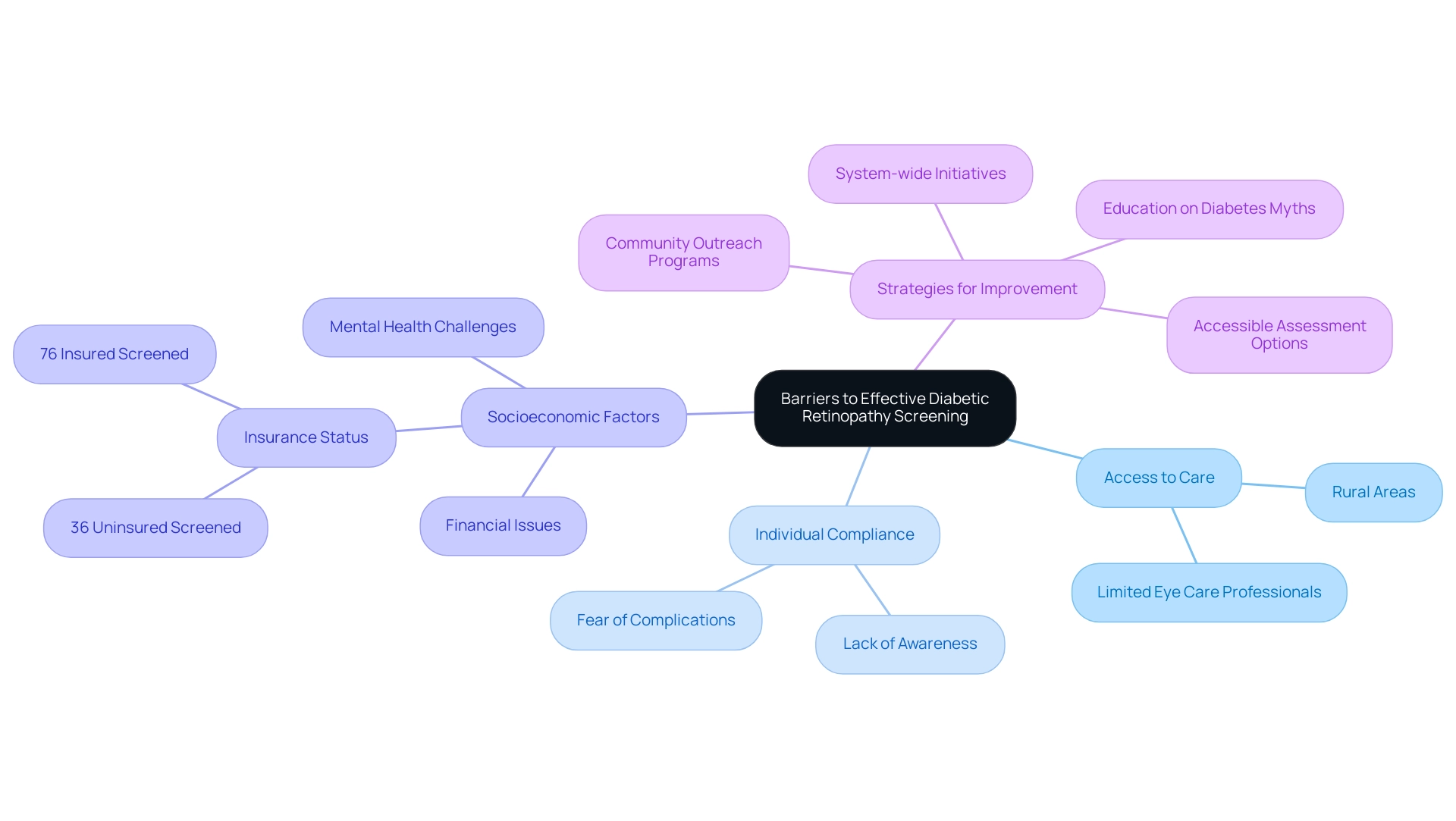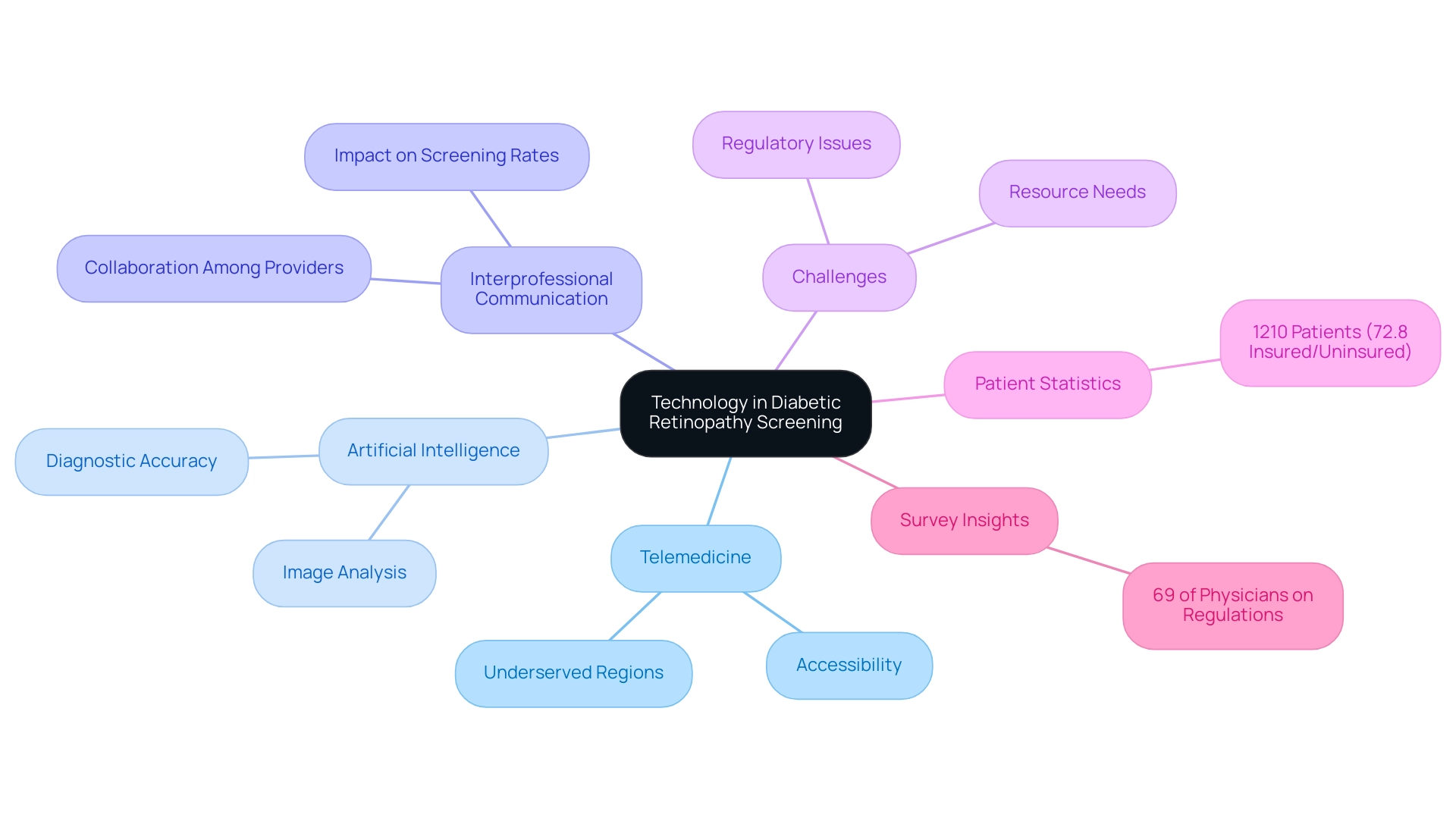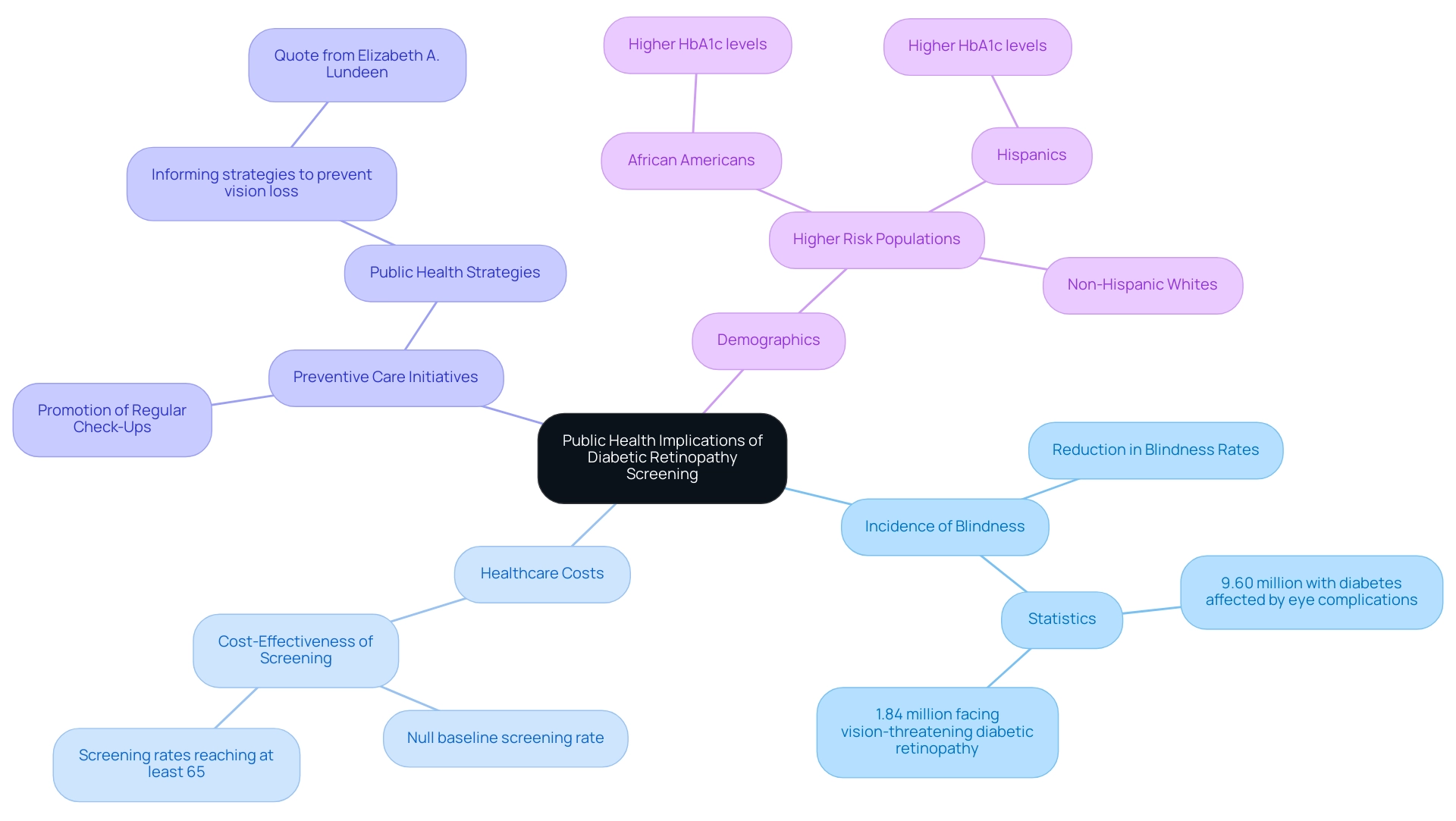Overview
Diabetic retinopathy screening is essential for early detection and prevention of vision loss in individuals with diabetes, as it identifies eye diseases that can progress silently and lead to blindness. The article underscores its importance through evidence of reduced blindness rates due to early detection, various screening methods including technological advancements like teleophthalmology and AI, and the need for public health initiatives to overcome barriers to access and awareness.
Introduction
The rising prevalence of diabetic retinopathy underscores the urgent need for effective screening practices among individuals with diabetes. As a leading cause of vision loss, this condition often progresses unnoticed until significant damage has occurred, making early detection critical.
This article delves into the multifaceted aspects of diabetic retinopathy screening, exploring traditional methods alongside innovative technological advancements such as teleophthalmology and artificial intelligence. It also addresses the barriers that hinder effective screening, particularly in underserved communities, and emphasizes the public health implications of routine eye examinations.
By understanding the importance of proactive screening, healthcare providers and patients alike can contribute to reducing the incidence of vision impairment and enhancing overall health outcomes.
Understanding Diabetic Retinopathy Screening: A Vital Preventive Measure
Diabetic retinopathy screening is a crucial preventive measure for individuals diagnosed with type 2 diabetes, as it tests for eye disease related to diabetes. This process involves a comprehensive assessment of the retina to detect early signs of diabetes-related eye condition, a progressive illness that can result in significant vision loss or even blindness if not addressed swiftly. Significantly, diabetes-related eye disease often progresses quietly, usually showing no signs until considerable harm has taken place.
Regular evaluations, such as diabetic retinopathy screening, are essential; by detecting the condition in its early stages, patients can implement timely interventions to control their diabetes and mitigate the risk of vision loss. Recent findings emphasize the significance of early detection through diabetic retinopathy screening, as shown by a meta-analysis indicating no substantial connection between the use of insulin or oral medication and the occurrence of eye disease, which implies that proactive screening is essential regardless of medication type. Furthermore, statistics indicate that among individuals aged 85 years and older, the occurrence of diabetes-related eye disease is significant, with approximately 282,000 cases reported.
It is also significant that for the first time in over fifty years, sugar-related eye disease and maculopathy have stopped being the primary causes of certifiable blindness among working-age adults in England and Wales. This shift emphasizes the effectiveness of early detection, particularly through diabetic retinopathy screening, and the essential role of regular checks in maintaining vision health. Additionally, a systematic review conducted in Ethiopia followed PRISMA guidelines and provided valuable insights into the prevalence and risk factors associated with diabetes-related eye disease, emphasizing the importance of understanding this condition in various populations.
Methods of Diabetic Retinopathy Screening: Traditional and Innovative Approaches
Diabetic retinopathy screening encompasses a variety of methods, ranging from traditional dilated eye exams to innovative technological approaches. The conventional technique involves the administration of eye drops to dilate the pupils, enabling eye care professionals to thoroughly examine the retina for any abnormalities. However, this approach can pose difficulties; for example, a study revealed that 7 individuals (11.7%) required help to retract their upper eyelid during conventional assessments.
Recent technological advancements have paved the way for teleophthalmology, which facilitates diabetic retinopathy screening through remote examination using high-resolution imaging and the digital transmission of retinal images. This method not only enhances the process of diabetic retinopathy screening but also increases accessibility for patients who may face geographical or logistical barriers. The research named ‘Comparison of Imaging Techniques for Diabetes-Related Eye Disease’ showed the effectiveness of different imaging methods, indicating a degree of consensus in the assessment of eye disease severity among patient-operated and technician-operated smartphone cameras in relation to the gold standard.
Moreover, the incorporation of artificial intelligence (AI) technologies is changing the field of diabetes eye disease evaluation. These AI-driven tools are being developed to analyze retinal images effectively and precisely, thereby optimizing the evaluation process and enhancing outcomes for individuals. As Martha E. Ryan states, ‘There are compelling reasons to continue to consider the use of smartphone technology.’
Together, these advancements signify a crucial evolution in methods for diabetic retinopathy screening, ultimately aiming to improve care and accessibility for individuals.
Overcoming Barriers to Effective Diabetic Retinopathy Screening
The early detection and prevention of vision loss in individuals with diabetes is critical through diabetic retinopathy screening. However, various barriers can impede its effective implementation, particularly in rural areas where access to specialized eye care professionals is limited. This scarcity leaves many individuals without essential services.
Additionally, individual compliance remains a significant challenge; numerous people with type 2 diabetes may not prioritize diabetic retinopathy screening, often due to a lack of awareness regarding the potential complications associated with their condition. Alarmingly, several individuals with over 10 years of experience living with diabetes reported never receiving a detailed explanation of how diabetes can lead to blindness. As one individual expressed, ‘Now, I heard [that with] diabetes you can go blind; that’s actually kind of scary to me.’
‘That would be pretty horrible, being blind.’ This fear, exacerbated by socioeconomic inequalities and mental health issues, leads to a gap between individuals and healthcare providers regarding the significance of diabetic retinopathy screening. For example, only 36% of uninsured individuals receive yearly evaluations, compared to 76% of insured Americans, emphasizing the socioeconomic obstacles encountered by many individuals.
To empower individuals and eliminate anxiety over diabetes complications, multifaceted strategies are essential. These should encompass:
- Community outreach programs designed to inform individuals about the importance of regular eye check-ups
- The development of more accessible assessment options
The Integrative Wellness Center promotes a holistic approach that tackles the root causes of diabetes, highlighting the significance of educating individuals in dispelling diabetes myths.
For example, common misconceptions, such as the belief that diabetes is an inevitable progression to severe complications, can be challenged through accurate information and support. Additionally, healthcare executives emphasize the importance of system-wide initiatives to tackle these inequalities, especially focusing on underprivileged urban communities to enhance health results and boost evaluation rates. By fostering a supportive environment that educates individuals and dispels myths, the Integrative Wellness Center aims to help people find peace in their lives and reduce worries about diabetes complications.
The Role of Technology in Advancing Diabetic Retinopathy Screening
The integration of technology is crucial in enhancing diabetic retinopathy evaluation processes. Telemedicine has emerged as a significant advancement, enabling individuals to undergo screenings without the necessity of extensive travel, a critical advantage for those residing in underserved regions. This accessibility is vital, given that a total of 1,210 patients, or 72.8%, were either publicly insured or uninsured, highlighting the need for more inclusive healthcare solutions.
Moreover, recent advancements in artificial intelligence (AI) are transforming the landscape of diabetes-related eye disease detection. AI-driven technologies facilitate rapid and precise image analysis, which is instrumental in achieving earlier diagnosis of diabetic retinopathy. By streamlining the evaluation process and improving diagnostic accuracy, these technological innovations not only enhance patient care but also significantly elevate the overall quality of healthcare services available to those at risk.
Furthermore, the significance of interprofessional communication in evaluation performance, as emphasized in a secondary CART analysis, highlights how effective collaboration among healthcare providers can enhance testing rates. Furthermore, a survey of physicians in Pakistan indicated that approximately 69% agreed or strongly agreed that regulations were insufficient to guard against malpractice, emphasizing the challenges faced in implementing telemedicine and AI technologies. Looking forward, boosting resources for telemedicine and further enhancing AI-driven healthcare platforms will be crucial for ongoing progress in diabetes eye condition evaluation.
Public Health Implications of Diabetic Retinopathy Screening
The public health consequences of diabetic retinopathy screening are substantial. Effective evaluation programs are crucial in significantly reducing the incidence of blindness among individuals with diabetes. This reduction not only improves the quality of life for patients but also reduces the healthcare expenses linked to advanced eye diseases, especially in populations with a null baseline assessment rate or where assessment rates reach at least 65%.
By promoting regular check-ups, public health initiatives can foster a culture of preventive care, leading to enhanced diabetes management and overall health results across communities. Recent statistics show that in 2021, around 9.60 million people in the U.S. with diabetes—about 26.43%—were impacted by eye complications related to the condition, with 1.84 million facing vision-threatening variations of the illness. This emphasizes the pressing requirement for proactive evaluation methods, particularly given that African Americans and Hispanics with diabetes often exhibit higher HbA1c levels than non-Hispanic whites, elevating their risk of eye complications.
Elizabeth A. Lundeen from the CDC emphasizes that,
These data can be used to inform strategies and interventions to prevent vision loss among Medicare beneficiaries with diabetes.
As awareness of diabetic retinopathy screening increases, so does the potential for enhanced public health outcomes through systematic initiatives.
Conclusion
The significance of diabetic retinopathy screening cannot be overstated, as it serves as a vital preventive measure against severe vision impairment in individuals with diabetes. Early detection through regular screenings allows for timely interventions, which are crucial given that diabetic retinopathy often progresses without noticeable symptoms. Traditional methods, while effective, face challenges that can be addressed by integrating innovative technologies like teleophthalmology and artificial intelligence. These advancements enhance accessibility and diagnostic accuracy, thereby improving patient outcomes.
However, multiple barriers still hinder effective screening, particularly in underserved communities. Limited access to eye care professionals and a lack of awareness among patients about the risks associated with diabetic retinopathy contribute to low screening rates. Addressing these issues requires a multifaceted approach that includes:
- Community education
- System-level interventions aimed at increasing access and understanding of the importance of regular eye examinations
The public health implications of routine diabetic retinopathy screening are profound. By fostering a culture of preventive care, healthcare systems can significantly reduce the incidence of blindness among individuals with diabetes, ultimately improving quality of life and decreasing healthcare costs. As the prevalence of diabetic retinopathy remains a pressing concern, it is essential for both healthcare providers and patients to prioritize proactive screening measures. This collective effort will be instrumental in mitigating vision loss and enhancing health outcomes for those at risk.
Frequently Asked Questions
What is diabetic retinopathy screening and why is it important?
Diabetic retinopathy screening is a preventive measure for individuals with type 2 diabetes that tests for eye disease related to diabetes. It assesses the retina to detect early signs of diabetes-related eye conditions, which can lead to significant vision loss or blindness if not addressed promptly.
How does diabetic retinopathy progress, and what are the implications of early detection?
Diabetes-related eye disease often progresses silently, showing no symptoms until significant damage has occurred. Early detection through screening allows patients to implement timely interventions to manage their diabetes and reduce the risk of vision loss.
What recent findings highlight the importance of diabetic retinopathy screening?
A meta-analysis indicated no significant link between the use of insulin or oral medication and the occurrence of eye disease, underscoring the necessity of proactive screening. Additionally, there were approximately 282,000 reported cases of diabetes-related eye disease among individuals aged 85 and older.
What has changed regarding the causes of certifiable blindness among working-age adults in England and Wales?
For the first time in over fifty years, sugar-related eye disease and maculopathy are no longer the primary causes of certifiable blindness among working-age adults, highlighting the effectiveness of early detection through diabetic retinopathy screening.
What are the different methods used for diabetic retinopathy screening?
Diabetic retinopathy screening includes traditional dilated eye exams and innovative technological approaches. The conventional technique involves using eye drops to dilate pupils for a thorough retinal examination, while newer methods include teleophthalmology and AI-driven tools for remote examination and image analysis.
What are the advantages of teleophthalmology in diabetic retinopathy screening?
Teleophthalmology enhances diabetic retinopathy screening by allowing remote examination using high-resolution imaging and the digital transmission of retinal images, increasing accessibility for patients facing geographical or logistical barriers.
How is artificial intelligence being utilized in diabetic retinopathy screening?
AI technologies are being developed to analyze retinal images effectively and accurately, optimizing the evaluation process and improving outcomes for individuals with diabetes-related eye disease.
What challenges are associated with traditional diabetic retinopathy screening methods?
Traditional methods, such as dilated eye exams, can present difficulties for some patients, such as requiring assistance to retract the upper eyelid during assessments.




